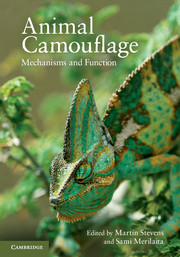Book contents
- Frontmatter
- Contents
- Contributors
- 1 Animal camouflage
- 2 Crypsis through background matching
- 3 The concealment of body parts through coincident disruptive coloration
- 4 The history, theory and evidence for a cryptic function of countershading
- 5 Camouflage-breaking mathematical operators and countershading
- 6 Nature's artistry
- 7 Camouflage behaviour and body orientation on backgrounds containing directional patterns
- 8 Camouflage and visual perception
- 9 Rapid adaptive camouflage in cephalopods
- 10 What can camouflage tell us about non-human visual perception? A case study of multiple cue use in cuttlefish (Sepia spp.)
- 11 Camouflage in marine fish
- 12 Camouflage in decorator crabs
- 13 Camouflage in colour-changing animals
- 14 The multiple disguises of spiders
- 15 Effects of animal camouflage on the evolution of live backgrounds
- 16 The functions of black-and-white coloration in mammals
- 17 Evidence for camouflage involving senses other than vision
- Index
- Plate section
- References
15 - Effects of animal camouflage on the evolution of live backgrounds
Published online by Cambridge University Press: 05 June 2012
- Frontmatter
- Contents
- Contributors
- 1 Animal camouflage
- 2 Crypsis through background matching
- 3 The concealment of body parts through coincident disruptive coloration
- 4 The history, theory and evidence for a cryptic function of countershading
- 5 Camouflage-breaking mathematical operators and countershading
- 6 Nature's artistry
- 7 Camouflage behaviour and body orientation on backgrounds containing directional patterns
- 8 Camouflage and visual perception
- 9 Rapid adaptive camouflage in cephalopods
- 10 What can camouflage tell us about non-human visual perception? A case study of multiple cue use in cuttlefish (Sepia spp.)
- 11 Camouflage in marine fish
- 12 Camouflage in decorator crabs
- 13 Camouflage in colour-changing animals
- 14 The multiple disguises of spiders
- 15 Effects of animal camouflage on the evolution of live backgrounds
- 16 The functions of black-and-white coloration in mammals
- 17 Evidence for camouflage involving senses other than vision
- Index
- Plate section
- References
Summary
Research on camouflage focusses on the ways animals make themselves inconspicuous against their background (Thayer 1909; Cott 1940; Ruxton et al. 2004). A common means of achieving inconspicuousness involves crypsis via background matching. In the visual domain we focus on here, this means possessing a phenotype that matches the colours, patterns and brightness of its surrounding background (Stevens & Merilaita 2009). The traditional focus on animals being the active players that match themselves against a passive background is well justified when the background is not a live entity. In many cases, however, animals’ immediate surroundings are either plants or larger animals. Examples include ambush predators on either flowers or foliage, herbivores on plants and small parasites on large hosts. In such cases, the background organisms may actually be active players that coevolve with the animals that use them as a backdrop. This important feature of animal camouflage requires detailed evaluation.
- Type
- Chapter
- Information
- Animal CamouflageMechanisms and Function, pp. 275 - 297Publisher: Cambridge University PressPrint publication year: 2011



